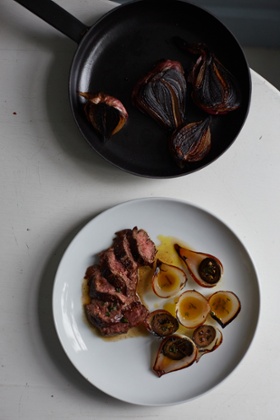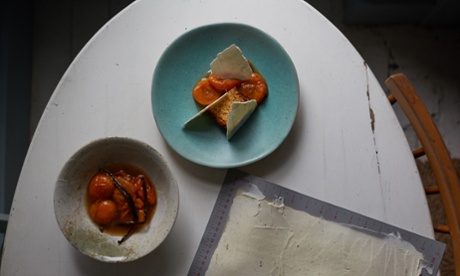Ed Smith: ‘I go to restaurants with half an eye on the craft, effort and innovation behind each dish.’ Photograph: Elena Heatherwick/Guardian Our new resident cook left his City job for the kitchen, and learned that, while cheffing skills are hard-won, restaurant-style presentation is easy
The email was sent at about 1am and closed with the line: "You have no idea what you're getting yourself into." I brushed the comment off " perhaps feeling this was just chef bravado from the email's author, James Lowe " but I suppose in many ways (every way?), he was absolutely right.
I'd just turned my back on five years as a solicitor at a major international firm and all the training that went before, had signed up for a chef's course at Westminster Kingsway College, and I was asking to have a go in the kitchen at James and Isaac McHale's celebrated pop-up The Young Turks at the Ten Bells. When I suggested I could chuck a few pieces of buttermilk chicken in the fryer for them, I had no idea what it was like to work 16-hour days on your feet (the fatigue is comparable, but very different, to a corporate all-nighter); I had no idea what I would do once the six-month catering course was over; and I had no idea what it would really be like to "follow your dream", "do what you love" or, more pertinently, live without the City salary.
That was about three-and-a-half years ago. Two years earlier, I'd started writing a food blog. The intention was simply to have a creative outlet, an escape from regulatory reviews and triple-fact-checking witness statements. Importantly, I wanted it to make myself cook something new and visit a new restaurant each week, rather than eat all meals at my desk.
I kept quiet about this strange little hobby for a long time. Embarrassed, probably, about colleagues and friends finding out I was "a food blogger"; it's a term I felt was spat, rather than spoken. Negative feelings were and are still based on an assumption that restaurant bloggers are all about blagging and freebies and intrusive photo-taking. There's never smoke without fire, but for me at least, a visit to a restaurant is first and foremost about eating good food with friends.
Actually, that's not entirely true. I also go to restaurants with half an eye on the craft, effort and innovation behind each dish. Very often, the techniques, ingredients and combinations are stimulating " to the point that I'll try to recreate something or everything about it at home. I'm still ruminating on the sweet pickled courgettes I had in a brunch dish in Copenhagen two weeks ago (they'll be going into a dessert, I think). Eating out informs and inspires my cooking.
Though I write recipes, develop menus and occasionally cook at pop-ups, I never did become a "proper" chef. I realised over the first year of my career change that what I enjoyed most was documenting the best people along every step of the food chain " from farmer through chef and consumer. So that's what I do. But I also take great enjoyment from using cheffy techniques and incorporating ideas in my cooking gleaned from eating out regularly. It's actually something I think all home cooks should do. Though there's no need to give up the day job to have a go.
Burnt onions and bavette
Restaurant chefs have the confidence to burn things, and we should too. You might have noticed onion petals with blackened edges on the side of artfully presented starters and mains: The Young Turks used to do a lamb's heart and anchovy dish with pickled cucumbers spooned into the onion petals; Tomos Parry adorns his Galician steak at Kitty Fisher's with the same; and every Turkish mangal chef was doing it for years before them, dousing the cooked allium with a pomegranate vinaigrette. The char around the edges is delicious; the segments soften and sweeten through residual heat. Great with beef or lamb. The vinaigrette dressing is important.

Serves 2
Sunflower oil
2 sweet French onions
3 tbsp extra virgin rapeseed oil
1 tbsp sherry vinegar
1 tsp golden caster sugar
Leaves from 3 sprigs of thyme
Sea salt and black pepper
300g bavette steak
10g butter
Spring greens or turnip tops, trimmed and shredded to 1cm-wide strips
2 pickled walnuts, sliced thinly across the round
1 tbsp tepid water
1 Place a heavy-based pan on a hot hob. Add a tablespoon or two of sunflower oil. Cut the onions in half from root to tip, trimming the root but keeping the skin on. Place in the pan, cut side down, rubbing over the oil, and cook for 10 minutes until blackened. Press down occasionally. Turn over and let sit on the round, skin-covered side for another 5-10 minutes until the onion softens. Then cook for 3-5 minutes more on the cut side. Remove from the heat.
2 Make a dressing in a small mixing bowl by whisking the rapeseed oil, vinegar, sugar, thyme leaves and a good pinch of salt and black pepper until emulsified. When they've cooled a little, separate the onions and discard the skin. Put the petals in the dressing and ensure each is well coated.
3 Cook the bavette to your liking. I put the steak straight from the fridge on a very hot, oiled pan, cooking for 80 seconds on each side, before adding a good knob of butter and cooking for 30 seconds longer on each side. Then I rest the steak on a warm plate for 4-5 minutes, before slicing on an angle across the grain.
4 Blanch the greens for 40 seconds and coat with a touch of dressing. Plate the onions, spoon the dressing into them and add walnut slices. Deglaze the frying pan with some water and pour this over the steak with the remaining dressing and any resting juices.
Mascarpone shards

There are a number of things that make restaurant chefs stand out from home cooks. These include preparation, efficiency and presentation skills. The first two take time and repetition to perfect, but you can make quick strides with the last. Many contemporary restaurant desserts are adorned with thin shards of meringue or other dehydrated and crisp materials. These frozen mascarpone shards are an easy way of achieving the same aesthetic effect. Crucially, they're also delicious, a kind of cheat's ice-cream. Serve quickly, balanced against or on top of poached fruits, cakes or anything creamy.
Serves 4-6
250g mascarpone cheese
30g icing sugar
Seeds from 1 vanilla pod
1 Put the mascarpone in a bowl. Add the icing sugar and vanilla seeds. Beat thoroughly with a spatula until the mascarpone is loose and well mixed.
2 Use a palette knife to spread the mascarpone over the baking sheet to a relatively even 2mm depth. Place this in the freezer for 2-3 hours until frozen.
3 Break into large shards and either serve immediately, or keep in the freezer in a sealed container until you want to use them.
Ed Smith is a food writer and blogs at rocketandsquash.com. Twitter: @rocketandsquash












